Gluten free yeast free bread, no kneading and leavening needed! In just one hour you will be able to enjoy your soft vegan gluten free bread made without eggs and xanthan gum!
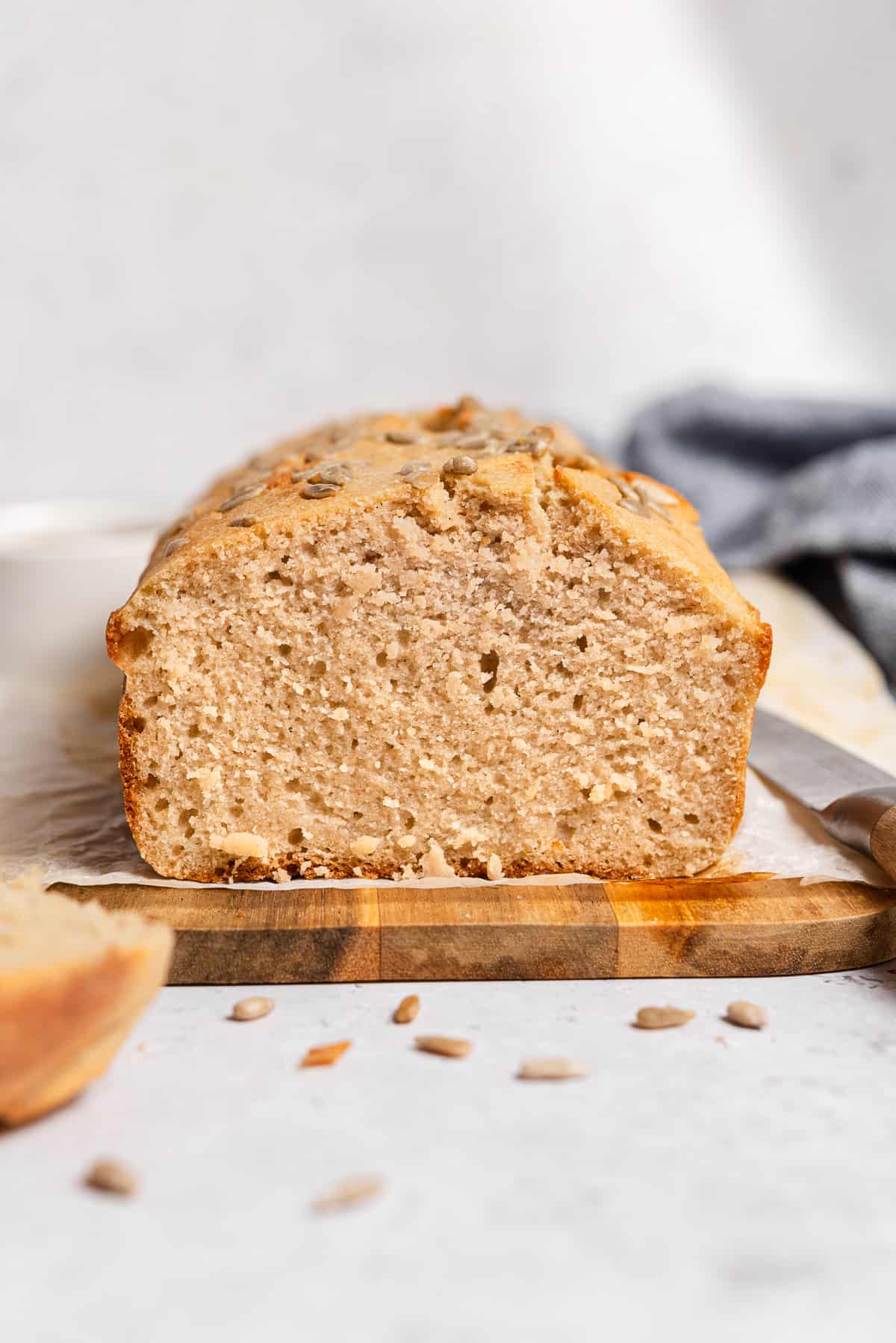
Jump to:
In my endless experiments with naturally gluten free flours (as in, no store bought flour blends), improving and varying my gluten free bread recipes has become pretty much a mission for me.
So I'm pretty happy that after several attempts I have finally managed to make a soft gluten free yeast free bread too and I can share it with you, gluten and yeast sensitive fellows! *fist bump*
This gluten-free bread without yeast is also:
- DAIRY FREE
- EGG FREE
- NUT FREE
- VEGAN
- HIGH IN PROTEIN
- with LESS CARBS THAN REGULAR GLUTEN FREE BREAD
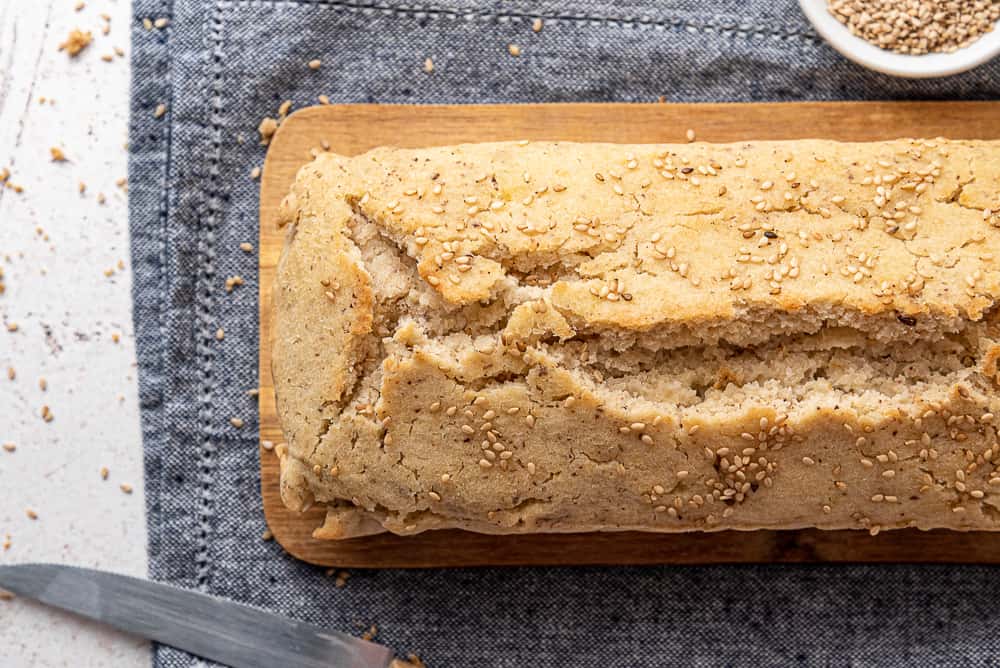
The texture of this bread reminds me of the focaccia bread that my mom and my grandma used to bake when I was a kid, rich and soft inside and slightly crunchy on the outside.
And oh the smell of baked bread right out of the oven, all around the house, I just couldn't wait to cut a slice for myself. Even though I ended up burning my mouth every time. SO worth it though.
Same happens with this gluten and yeast free bread loaf. In fact, the other day I had to leave a note on top, saying "do not cut the bread, I have to take the photos first!". Because I know my sweetheart all too well.
Besides the brown rice flour, I have used quinoa and amaranth flours, rich in fibers, protein and minerals.
Being it a yeast free bread, no leavening is needed, because the cream of tartar and the baking soda will activate while the bread is baking.
I mean, isn't this awesome!? It sure is because it means that in just one hour your bread will be ready to be enjoyed both with savory foods and jams or spreads! *fist bumps again*
Also, this easy gluten free bread is sliiightly moist inside, which will help to keep it soft for 2 to 3 days, if kept well sealed in a bag.
TIPS and SUBSTITUTIONS
Yes and no. The flaxseed "gel" helps binding the gluten free flours and it also gives a softer texture to the bread.
If you can't or dont' want to use the flax seeds, you can replace them with a couple more table spoons of starch and reduce the other flours accordingly.
You sure can! They can be replaced with brown rice flour, millet, sorghum or buckwheat (you may need to add a bit of water, especially with buckwheat or millet)
Cream of tartar is a plant-based acidic agent that reacts to baking soda and allows batters to instantly rise while being baked.
That is why no rising time is needed before baking.
More gluten free yeast free bread ideas
If you need more recipes for gluten free yeast free bread, check these out:
- Crispy flatbread, perfect as an appetizer!
- Yeast free buns, just what you need to make a sandwich or for a burger night
- Quick no yeast naan bread, easy and delicious
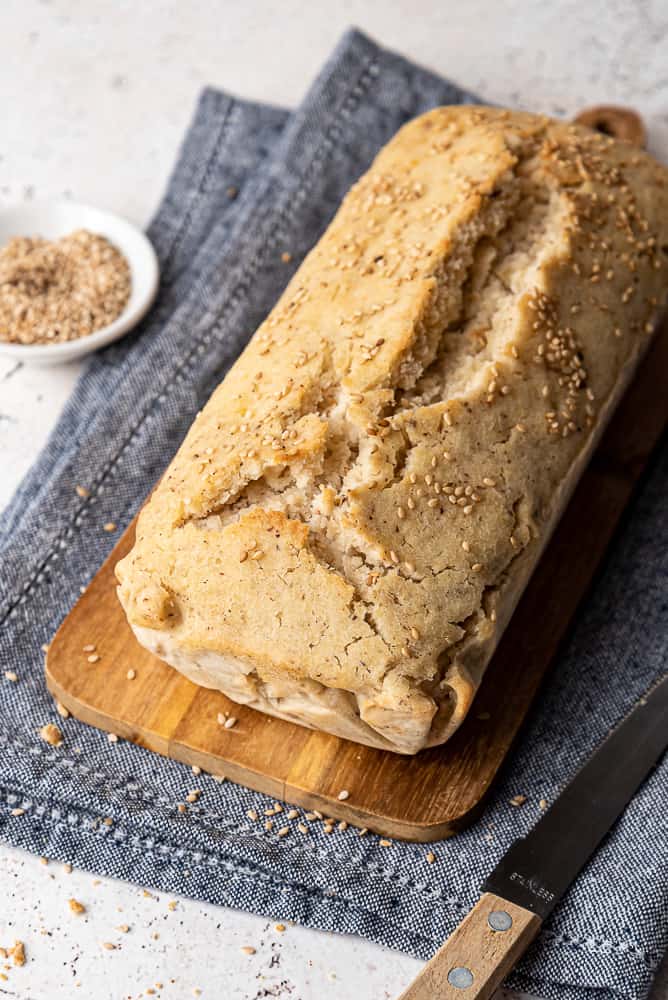
If you make this recipe or have questions, leave me a comment down here! And a 5 star rating if you have loved it would help me grow the blog 😉
For all the updates, follow me on Pinterest and Instagram and tag me if you make this or any of my recipes! I absolutely LOVE to see what you make and share it in my stories!
Ciao!
Sonia
📖 Full Recipe
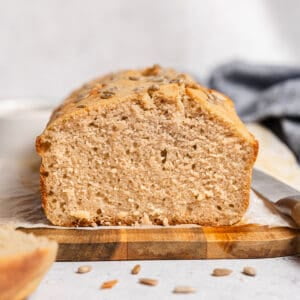
Soft Gluten free Yeast free Bread | Vegan + Homemade Flour Blend
Equipment
- kitchen scale
- 1 small bowl/cup
- 1 spoon/spatula
- 1 bowl
- 1 loaf pan (25x11 cm) or (9 x 5 inches)
- parchment paper
Ingredients
- 2 tablespoon ground flax seeds + 6 tablespoon water
- 100 grams gluten free quinoa flour * (replace with brown rice flour for a more neutral flavor)
- 100 grams gluten free amaranth flour * (replace with brown rice flour for a more neutral flavor)
- 180 grams gluten free brown rice flour
- 120 grams gluten free potato (or other) starch
- 3 teaspoon (homemade) baking powder (or 1 teaspoon baking soda + 2 teaspoon cream of tartar powder)
- 1 tsp salt
- 420 grams water
- 2 tablespoon extravirgin olive oil
Instructions
- Mix the ground flax seeds and the 6 tablespoon of water and let rest for a few minutes, until it turns gelatinous
- Pre-heat the oven at 180° C / 350 F
- In a bowl mix well all the flours, starch, baking soda, cream of tartar and salt
- In another bowl mix the water and the olive oil and add it to the other bowl, carefully mixing and incorporating all the ingredients until you have a smooth and uniform batter (you won't get a dough that can be kneaded and shaped, but a cake-like batter)
- Incorporate the flaxseed "gel" to the batter
- Pour the batter into a loaf pan, previously greased with olive oil or lined with parchment paper, sprinkle some seeds on top (if desired)
- Bake for 40 to 50 minutes, depending on your oven. When the loaf is nice and golden-brown insert a toothpick into the center of the loaf, when it comes out dry (or covered in small dry crumbs) the loaf is ready
- Once out of the oven, to avoid crumbling, let it cool down completely before slicing
- Check the post for tips and substitutions!
Important note
- If you are using only brown rice flour or buckwheat flour (+ gluten free starch), you can omit the flax seed gel and still obtain a nice, soft and slice-able loaf.


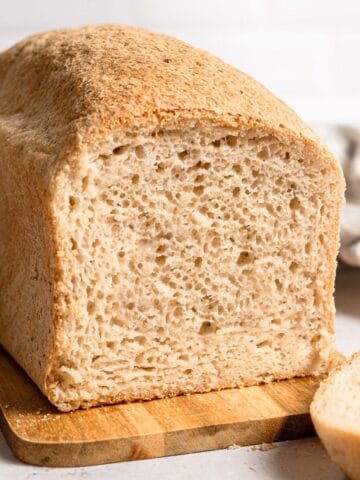


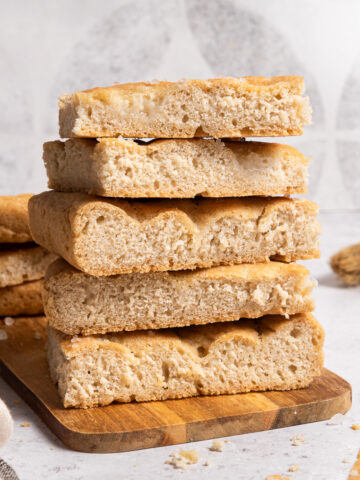
Elena says
Hi, this recipe looks amazing ! 🙂 im just gluten, oat and rice intolerant. Is it possible to do this recipe just with amaranth and quinoa flour or by increasing the starch? or any other ideas? Thanks in advance for your answer 🙂
Sweet Sensitive Free says
Hi Elena! I have not tried with just amaranth and quinoa but I'd say there's no problem with that, maybe bring the starch up to 150 gr + 350 gr of amaranth and quinoa (flours+starch have to be 500 gr total). If you can eat it, you can use brown millet too.
Thank you for your comment! I'd love to know how it goes and how you liked the bread!
Sonia x
Sherry says
Can i use corn flour instead of brown rice flour? Thanks
Sweet Sensitive Free says
Hi! I haven't tried it with corn flour, but I don't think it should be a problem. You may only need to adjust the amount of water. I'm not sure how much water corn flour absorbs, so maybe start with less of what it's in the recipe and adjust adding a little bit of water at times. The final batter should resemble a thick cake batter.
Elizabeth says
The bread looks and smells delicious. This is the second time I’ve made it, but my cooking time is significantly longer. I end up cooking it for 65-70 minutes. My oven works well. ??
Sweet Sensitive Free says
Hi! I'm so glad you like this bread! It can really depend on how your oven can keep the temperature. You may try to raise the temperature a bit (190 Celsius / 370 Fahrenheit), but I wouldn't go beyond it or the bread might quickly overcook outside and not inside.
Another option might be reducing a little the amount of water in the batter to make it less liquid. It may alter the texture though. Let me know how the next try goes!
Elizabeth Bennett says
Thanks for the suggestions! Im baking my third loaf now at 360F. I had been 75 min and I just put it back in for another 15min. I open to more suggestions, because I love the flavor of this bread. I will make it over and over until I get it right 😊.
I used the exact flours called for weighed in grams. I have followed all directions as listed. My oven works, because I’ve baked plenty of other dishes with no issue.
My bread is not rising well. It is much more dense and moist than in the picture. ? I did not try reducing the water, but that’s my next plan.
Sweet Sensitive Free says
Hello again! I am so glad you love this bread, thank you!
Such great difference in baking time is a real mistery to me. I just remade it the other day and it took no more than 40 minutes to bake.
The only other reason I can imagine is the flours and how finely ground they are, which may vary the way they absorb liquids.
Please do let me know how the next bakes go 🙂
Chef W says
Baking soda (and powder) is leavener. 🙂
Sweet Sensitive Free says
Yup. Baking soda is a leavening agent when mixed with an acidic agent, like cream of tartar, lemon or vinegar (in fact, baking powder is often made of baking soda and cream of tartar). It is not a yeast though.
Lupita says
Thanks for the recipe. My bread rose well and could already see the bubbles forming before it went in the oven. However after 65 minutes of baking, it still didn't seem to be baked through. It still tastes good and will try again! Thank you.
Sweet Sensitive Free says
Thank you for your feedback! 65 minutes do seem like a long time indeed, though baking times can change from oven to oven. I am glad you enjoyed this bread 🙂
Ryan P says
Hi I don’t see the amount of cream of tartar in the ingredients list
Sweet Sensitive Free says
Hi! You are absolutely right, because of an oversight I didn't write it in the recipe card, thank you for pointing it out! I have fixed it, but anyway doses are 1 teaspoon baking soda + 2 teaspoons cream of tartar (or you can make this homemade baking powder and use 3 teaspoons of it 🙂
Michele Khurana says
My first try with this recipe didn't produce the bread I had hoped for. I did eve as directed (only substituted "store-bought" baking powder for the homemade and ghee for the olive oil). I baked for about 42 minutes. NOT ENOUGH!! The bread was still too moist inside and the bottom half was condensed and uncooked. Not too happy with the flavor either. I'll try it with a few subs and definitely longer baking time and report back. I appreciate your efforts in creating the recipe though! 🤗
Sweet Sensitive Free says
Thank you for your feedback, I'll retest the baking time. Flavor wise, that's very personal, it really depends on what gf flours you like. For a more neutral flavor I often use only brown rice flour (+ the starch)
Michele Khurana says
Reading the comments, I see that most people had the same issue I did with the cooking time. Many similar recipes I've used called for even up to 90 minutes cooking time, even with the initial dough/batter being MUCH drier. I will try reducing the water considerably and test the results...
Janet Hribar says
I thought that the bread tasted very salty. Can the salt be cut down?
Sweet Sensitive Free says
Hi and thank you for your comment! After yours and other feedbacks I retested the recipe and updated it. One teaspoon of salt can surely be enough (saltiness is very "personal", but that's definitely an ingredient you can adjust to your own liking). I usually use a 9x5 inch pan (circa, Italian measurements are slightly different). The one you used might be slightly small, but the bread shouldn't rise too much in the oven. Did it "overflow" while baking?
Brit says
When you say potatoe starch is that just cooked potato?
Sweet Sensitive Free says
Hi! Potato starch is a hightly refined flour made from potato, it helps gluten free doughs/batters stick together. You can replace it with corn starch too if you'd like. Hope this helps!
Priyanka says
Is it necessary to use cream of tartar as it is acidic in nature
Sweet Sensitive Free says
Hi, cream of tartar is used as an acidic agent that reacting to baking soda will help the bread rise while baking. You can use storebought baking powder too (though it most likely contains cream of tartar too)
JD DC says
I made this today with 150g Sorghum, 50g Teff as substitute for quinoa and amaranth. 300g Bob's GF AP flour substitute for brown rice and potato flours. It did produce a cake like batter. 350F for 50 minutes, I took it out and it came clean with a toothpick test.
It was delicious with vegan butter and Miellerie Unheated Honey.
Sweet Sensitive Free says
Thank you for your comment, glad you enjoyed it! I'm happy to know this recipe also works with a commercial flour blend, very interesting!
Hiroshi says
The quinoa flour made it a bit strong, but the flavour overall is nice. Thank you for the recipe. I think I'll use it to make French toast to mellow it out a bit. 🙂
Ashley says
This sounds good! Could it be made using almond and coconut and possibly green banana flour? I have an assortment of these that I'd like to use. Thank you!
Sweet Sensitive Free says
Hi! Sorry for my belated reply. Unfortunately I've never tested this recipe with those flours so I can't guarantee a successful end result!
Sweet Sensitive Free says
Thank you for including my recipe!!!
Janet Hribar says
You did not specify what size loaf pan to use. Most Gluten free breads are usually in an 8x4 inch pan. When I dumped the batter in that pan, it rose to the top of the pan. I am baking it at 350 degrees. So I imagine that it may take up to an hour to bake.
What size pan did you use?